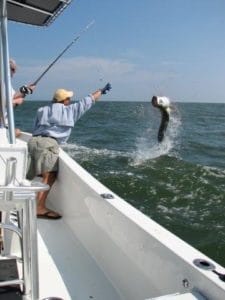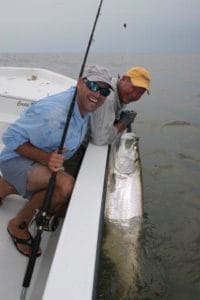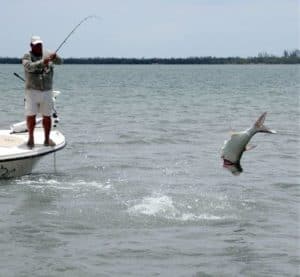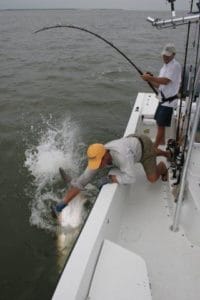by Bob McNally
Few fish are more game than tarpon.

Tarpon are amazingly strong and leap with the best of game fish. To hook and battle a tarpon should be on every angler’s bucket list.
They jump like wild fire, they are remarkably strong, and they readily strike plugs, flies and bait. Tarpon are abundant in tropical and semi-tropical settings and grow to enormous size. Fish in the 80- to 100-pound class are common, and tarpon over 150 pounds are caught regularly. And “baby” tarpon under 25 pounds are even frequently found in run-off ditches, coastal ponds and golf course water hazards.
Best of all, you don’t need a passport to have great tarpon fishing. Much of the world’s best silver king angling is available right at home, in the good ol’ U.S.A.
Here are some choice locations for great domestic tarpon action.
Boca Grande, Florida
Located at the mouth of Charlotte Harbor near the town of Fort Myers, Boca Grande has the largest known concentration of tarpon in the world. Historically, May and June are the top months for Boca Grande tarpon.
Fishing for silver kings is practiced several ways, with fly-rodders enjoying superb sight-casting sport on beach flats and at times for offshore “rolling” fish. In the pass, dozens of boats vertical jig or fish live crabs deep for tarpon. It’s crowded, but fishing is superb and crossed lines are surprisingly rare.
Full and new moon phases offer best pass tarpon fishing. During a good falling tide, fishermen can jump as many as a dozen fish. Tarpon run big at Boca Grande, with 80- to 130-pounders not uncommon. This is no place for a swim, either, as huge sharks (mainly hammerheads) mass to feed on tarpon. And it takes quite a shark to munch a 100-pound fish.
While this fishing can be done on-your-own, it’s smart to hire a guide, at least initially to learn the ropes. For fly rodders, one of the best is Phil O’Bannon (941-964-0359), www.Obannonscharter.com. Dave Markett (813-927-3474) is a top choice. Joel Brandenburg (813-267-4401) is another good one.
St. Simons Island, Georgia
Georgia has exceptional tarpon fishing near the famed “Golden Isles,” around the coastal town of Brunswick. Fishing is done within a couple miles of shore, and tarpon show in early June and offer consistent fishing through September, often well into October. On a good day, anglers will “jump” several fish, sometimes landing three or four. Anglers get a lot of 100-pounders, and some of these Georgia fish weigh close to 200 pounds—giants in the tarpon world.
Best action is during moving tides for anglers chumming with menhaden and using whole menhaden for bait.
Much of the best fishing is in broad sounds, bays and river mouths, and also just offshore area beaches near St. Simons Island. Although offshore tarpon fishing near Georgia’s barrier islands may sound like a big-boat game, this is ideal small-boat fishing. Offshore waters during summer normally are placid, and because the fishing is done within just a few miles of inlets and good marinas and never out of sight of land, it is perfect small-boat fishing. Tarpon over 100 pounds can be seen busting menhaden baits within 50 feet of the beach. There are opportunities for surf fishermen to hook tarpon, but landing them is a different matter.
Greg Hildreth (912-261-1763/866-GA-FISH9, www.georgiacharterfishing.com, and Tim Cutting (912-230-1814; www.fishthegeorgiacoast.com know the tarpon waters well in the St. Simons Island area.
Top hotels, motels, resorts and restaurants can be found on Sea, St. Simons and Jekyll islands.
Marathon/Islamorada, Florida Keys

This is as close to caught as most tarpon ever get. Almost tarpon these days get a quick photo and are released.
February and March is when tarpon begin to show in good numbers in the Middle Keys, most notably near the towns of Marathon and Islamorada. When the water temperature reaches 74 degrees, anglers using live silver mullet work around Seven-Mile Bridge, south of Marathon. They anchor or drift in channels around the bridge early and late in the day, and on a good outing can jump 10 to 12 fish. This is the best time to hook a truly big tarpon weighing in the 150-pound class, though most weigh 80-to-100 pounds.
In April, tarpon swarm around the bridge connecting Bahia Honda Key with West Summerland Key. Anglers fishing with mullet in the channel enjoy peak fishing from mid-May to mid-June.
Tarpon fishing remains good throughout the Middle Keys to the end of July. Through the summer and early fall plenty of small “resident” tarpon in the 30-to-60 pound class can be found around bridges at night, passes, and in canals.
Many gifted tarpon guides work the Middle Keys. Some of the best are Lenny Moffo (305-872-4683), Bus Bergman (305-743-7021), Dave Denkert (305-852-1425/305-393-5134), Eric VanDemark (305-258-9917/786-564-1540) and Steve Friedman (305-393-3474).
Venice, Louisiana
The nutrient-rich Mississippi River mouth, combined with the clear, deep and warm waters of the Gulf of Mexico, form a unique water mixture that has created some of the most incredible fishing found anywhere—and all of it is within fast striking distance of anglers working out of the town of Venice.
This area is an hour drive southeast of New Orleans. It was ground zero for hurricane Katrina, but the fishing is back in a big way, and facilities again are top-notch for visiting anglers.
From mid-summer through October, huge tarpon are found in bays near Venice and nearby Grand Isle. Fish commonly weigh 100 pounds, and every summer silver kings over 200 pounds are recorded. One recent autum, Louisiana legendary tarpon guide Lance “Coon” Schouest (inventor of the Coon Pop lure, 985-688-7633) led anglers to several 200-pound class tarpon, including a 210-pounder, caught, weighed, and released by Coon himself.
These are world-class fish, and they were all caught sight casting to cruising tarpon schools with special Coon Pop jigs.
Bill Butler has an excellent, full-facility fishing headquarters. There are superb facilities for visiting anglers, including launch ramp, lodging, restaurant, marina and tackle shop.
In addition to Coon Schouest, veteran angler Brandon Ballay guides for tarpon out of Venice Marina (985-534-9357).
Homosassa, Florida
Anglers who know tarpon speak about Homosassa on Florida’s central Gulf Coast the way golf fanatics revere Georgia’s Augusta National.
Few places on the planet have as many big tarpon as Homosassa. It’s a place made famous by world record fish caught by anglers like Al Plueger Jr., Stu Apte and Billy Pate. Fish over 150-pounds are ho-humers, and 200-pound fish are available, though few are landed.
Homosassa is most famous as a fly-rod fishing spot. But its clear, deep flats also are good for spin and plug fishermen.
If you’re new to tarpon fishing or want to catch your first on a fly, Homosassa is not the place to start. This is all sight fishing in deep water (10 feet common), and it’s not easy by any stretch of the imagination. Learn the tarpon ropes in the Florida Keys or Boca Grande. When you’ve got some fish under your belt, hire a guide and try Homosassa, and expect to consume humble pie—but you’ll likely see tarpon the size of urban autos.
Good tarpon fishing here can start in April, peaking in May and June. Some resident fish are always around, with 60- to 80-pounders average. Guides are a wise way to go. Try Phil Chapman (863-646-9445) or Mike Locklear (352-628-4207).
The Union Sportsmen’s Alliance website is designed to provide valuable articles about hunting, fishing and conservation for members of AFL-CIO affiliated labor unions and all sportsmen and sportswomen who appreciate hunting and fishing and want to preserve our outdoor heritage for future generations. If you would like your own story and experience from the outdoors to be considered for our website, please email us at [email protected].









